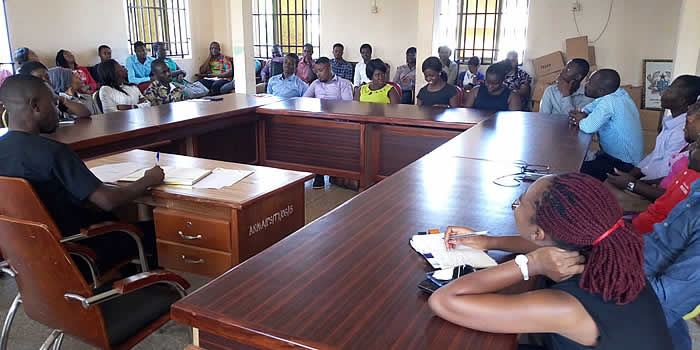

20 Health Care Delivery
The vision of the Health Sector is to ensure that diseases and avoidable deaths are kept to the barest minimum and every citizen has access to quality–driven, result–oriented, close–to–client focused and affordable health service by a well-motivated workforce. The Akuapem North Municipal Health Directorate, working under the Ghana Health Service has the mandate to implement approved health sector polices in such a manner as to ensure access to priority health interventions and to manage prudently resources available for provision of health services.
The Municipality has eight (8) sub-districts in terms of health service delivery as indicated in figure 1.3 below.
Health Facilities
The Municipality has both public and private health facilities that are spread across the entire Municipality based on their functions and the range of services they provide. The are two major hospitals, Tetteh Quarshie Memorial Hospital (government) and MEDICAS Hospital (private) both located at Mampong-Akuapem. The Centre for Scientific Research into Plant Medicine which is also located at Mampong is the only recognized Health Research Centre in the Municipality. The eight (8) health centres are located at Akropong, Larteh, Adawso, Mampong, Tinkong, and Mangoase. The thirty three (33) CHPS Compounds are also located or found in communities such as Twumguaso, Nanabanin, Kwamoso, Behenase, Tadankro, Akyeremanteng, Asenema, Obosomase, Mampong, Amanfro, Abiriw, Gbolo-Kofi, Abonse, Baware, Osabanyin, Tutu, Akuni, Amanokrom, Aseseeso, Apirede, Adonkwanta, Konko, Tinkong, Okorase, Akropong, Larteh, Otwitiri, etc.
Table 1.18 below shows the number of health facilities in the public and private sectors. It shows that the number of health facilities in the public sector is higher than that of private the health facilities. This means that in terms of accessibility to health facilities, the public sector has a wider coverage in the provision of health care.
In the remote or rural areas where accessibility to health facilities is limited, the health facilities provided there were mostly the CHPS Compounds. However they are inadequate in number since the Municipality has greater number of rural communities.
Even though there is an improvement in the number of health facilities in the Municipality (from 33 in 2013 to 47 in 2017), as indicated on Table 1.18 above, health service delivery especially in the rural communities still needs much attention due to inadequate residential accommodation for health workers. Figure 1.4 below shows the locations of the various facilities in pictorial form.
Staffing in the Health Sector shown in Table 1.19 below registered significant improvement over the period under review. Thus, from a total staff strength 411 to 516; comprising of 15 Doctors, 6 Physician Assistants and 242 Nurses. This has resulted in improvement in service delivery in the Sector.
Health Services
Table 1.20 below shows the various types of services rendered at the Tetteh Quarshie Memorial Hospital at Mampong.
Health Research Centers
The Municipality has a Health Research Center CRPM at Mampong which renders the services listed in table 1.21 below.
As indicated in table 1.22 below are the various services rendered at the CHPS compounds located in the Municipality.
Incidence of Diseases
Table 1.23 below the trend of occurrences of diseases in the Municipality. As indicated in the table, malaria continues to be the most reported disease at OPD followed by Upper Respiratory Tract Infections and Rheumatism and other joint pains in that order. Hypertension, Anaemia, diarrhea, intestinal worms and skin diseases could be seen to be on rise. Poor sanitation and poor hygiene practices could be attributed to the cause of malaria cases in the Municipality.
Mortality
Mortality in the Municipality is gradually reducing as indicated in the table below. However, these are the reported cases caused by the under-listed diseases.
From table 1.24 above, it can be observed that the total number of deaths has reduced from a total of 235 in 2015 to 212 in 2016 representing 9.79% reduction. This achievement has been due to some measures and programmes implemented by Health Directorate in collaboration with the Municipal Assembly.
It can also be noted that diseases such as HIV/AIDS, CVA, broncho pneumonia and other heart diseases as well as stroke, recorded higher deaths over the last four years. The Health Directorate in collaboration with the Municipal Assembly and other key stakeholders are implementing some initiatives or programmes to address the situation. It included the establishment of palliative and cancer center.
National Health Insurance Scheme (NHIS)
The NHIS was established by Act 650 in 2003 to replace the then “Cash and Carry” system and bridge the gap in access to health services. The Scheme was inaugurated in the municipality on 10th March, 2004 with a membership of 3200 with a fifteen member Board of Directors. The Municipal NHIS Office is situated at Abiriw. The performance of the Scheme has been encouraging over the years due to some initiatives by managers of the scheme. Below is the performance of the Akuapem North Municipal Assembly for the period 2014 to 2017:
From table 1.25 above, there has been some reduction in the NHIS membership from 2014 to 2016. This is due to a number of issues which included non-renewal of membership, non-collection or replacement of cards, etc. However, membership increased in 2017 by 13.5percent.
People living with HIV/AIDS
People living with HIV and AIDS are also the vulnerable in the Municipality even though there are inadequate data or statistics on the proportion of population with HIV/AIDS. Statistics from the MHMT report for 2017 disclosed that the HIV prevalence rate stood at 1.7% which is below the national prevalence rate of 2.4%.
Table 1.26 above shows the HIV/AIDS Counselling and Testing (HTC) trend analysis for the plan period of January – December (2014 – 2017). However, figures for 2017 are as at June i.e. mid-year. From the table, results for all the indicators reduced sharply between 2014 and 2015, by 2016 some increases were recorded. High results recorded in 2014 were as a result of programmes that were driven from the national level and implemented across all districts.
Form Table 1.27 above over the plan period the number of cases tested, ANC registrants, number receiving counselling and number testing positive had reduced. However, number tested positive for syphilis over the same period continues to rise. It therefore means some attention needs to be directed towards syphilis prevention to save unborn children from being infected. Effective programmes aimed at reducing the spread and transmission of HIV/AIDS and other related diseases will receive outmost attention by way of mainstreaming them into the development activities of the Municipality.
Date Created : 11/23/2017 1:16:35 AM













 facebook
facebook
 twitter
twitter
 Youtube
Youtube
 +233 593 831 280
+233 593 831 280 0800 430 430
0800 430 430 GPS: GE-231-4383
GPS: GE-231-4383 info@ghanadistricts.com
info@ghanadistricts.com Box GP1044, Accra, Ghana
Box GP1044, Accra, Ghana